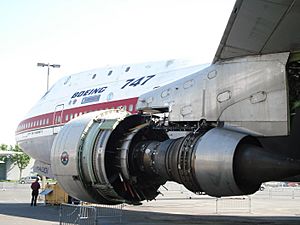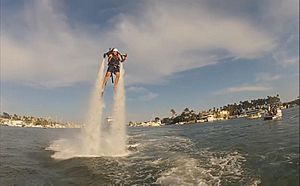Jet engine facts for kids
A jet engine is a type of air-breathing turbine engine, often used on aircraft. The principle of all jet engines is essentially the same. The engine draws air in at the front and compresses it. The air then combines with fuel and the engine burns the resulting mixture. The combustion greatly increases the volume of the gases which are then exhausted out of the rear of the engine.
The process is similar to a four-stroke cycle, induction, compression, ignition and exhaust - taking place continuously. The engine generates thrust because of the acceleration of the air through it - the equal and opposite force this acceleration produces (Newton's third law) is thrust.
A jet engine takes a relatively small mass of air and accelerates it by a large amount, whereas a propeller takes a large mass of air and accelerates it by a small amount. The efficiency of the process, like any heat engine, is determined by the ratio of the compressed air's volume to the exhaust volume.
The advantage of the jet engine is its efficiency at high speeds (especially supersonic speeds) and high altitudes. On slower aircraft, a propeller (powered by a gas turbine), commonly known as a turboprop is more common. Very small aircraft generally use conventional piston engines to drive a propeller.
Contents
Uses

Jet engines power jet aircraft, cruise missiles and unmanned aerial vehicles. In the form of rocket engines they power fireworks, model rocketry, spaceflight, and military missiles.
Jet engines have propelled high speed cars, particularly drag racers, with the all-time record held by a rocket car. A turbofan powered car, ThrustSSC, currently holds the land speed record.
Jet engine designs are frequently modified for non-aircraft applications, as industrial gas turbines or marine powerplants. These are used in electrical power generation, for powering water, natural gas, or oil pumps, and providing propulsion for ships and locomotives. Industrial gas turbines can create up to 50,000 shaft horsepower.
Jet engines are also sometimes developed into, or share certain components such as engine cores, with turboshaft and turboprop engines, which are forms of gas turbine engines that are typically used to power helicopters and some propeller-driven aircraft.
Types
There are a large number of different types of jet engines, all of which achieve forward thrust from the principle of jet propulsion.
| Type | short_description | advantages | disadvantages |
| Turbojet |
generic term for common variety |
simplicity of design |
basic design misses many
improvements |
| Ramjet |
Intake air is compressed
entirely by speed of oncoming air instead of compressor blades |
no or very few moving parts |
not well tested or popularized;
may not work |
| Scramjet |
Intake air is compressed but not
slowed to below supersonic; intake, combustion, and exhaust occur in a single constricted tube |
can operate at very high mach
numbers |
very difficult to simulate,
design, build, test. |
| Turboprop |
jet turbine engine used only as
powerplant to drive propeller shaft. |
high efficiency |
limited top speed; somewhat noisy |
| Propfan |
turbojet engine drives a propeller; like a turboprop but without ductwork. |
few advantages |
quite noisy, not used much anymore |
| Pulsejet |
Air enters a tube, the front of the tube is shut, fuel in the air ignites, exhaust vents from other end of tube. |
Very, very simple design; commonly used on model aircraft |
noisy, inefficient, parts subject to mechanical fatigue. |
| Pulse detonation engine |
Similar to a pulsejet, but combustion occurs as a detonation instead of a deflagration; may or may not need valves. |
Maximum theoretical engine efficiency |
Extremely noisy; parts subject to extreme mechanical fatigue; hard to start detonation. |
| Turborocket |
An additional oxidizer such as oxygen is added to the airstream to increase max altitude. |
Very close to existing designs; operates in very high altitude; wide range of altitude and airspeed |
Airspeed limited to same range as turbojet engine; Carrying oxidizer like liquid O2 can be dangerous. |
Images for kids
-
U.S. Air Force F-15E Strike Eagles
-
Jet engine during take-off showing visible hot exhaust (Germanwings Airbus A319)
-
Gloster Meteor F.3s. The Gloster Meteor was the first British jet fighter and the Allies' only jet aircraft to achieve combat operations during World War II.
-
Specific impulse as a function of speed for different jet types with kerosene fuel (hydrogen Isp would be about twice as high). Although efficiency plummets with speed, greater distances are covered. Efficiency per unit distance (per km or mile) is roughly independent of speed for jet engines as a group; however, airframes become inefficient at supersonic speeds.
See also
 In Spanish: Motor de reacción para niños
In Spanish: Motor de reacción para niños













